PRO285 - Public Relations in Japan: Culture & Social Media
VerifiedAdded on 2023/06/04
|11
|3092
|93
Essay
AI Summary
This essay examines the influence of Japanese culture on public relations practices, particularly focusing on the impact of social media. It begins by defining public relations and social media, highlighting their interconnectedness. The essay then delves into how Japanese culture, characterized by collectivism, hierarchy, and uncertainty avoidance, shapes communication and relationship-building. A case study on social media usage in Japan reveals its significant role in information dissemination, customer engagement, and even democratic participation. However, the essay also acknowledges the negative aspects, such as the spread of misinformation and cultural appropriation. It concludes that social media has profoundly impacted public relations in Japan, offering both opportunities and challenges for effective communication and relationship management, urging responsible usage and security measures.
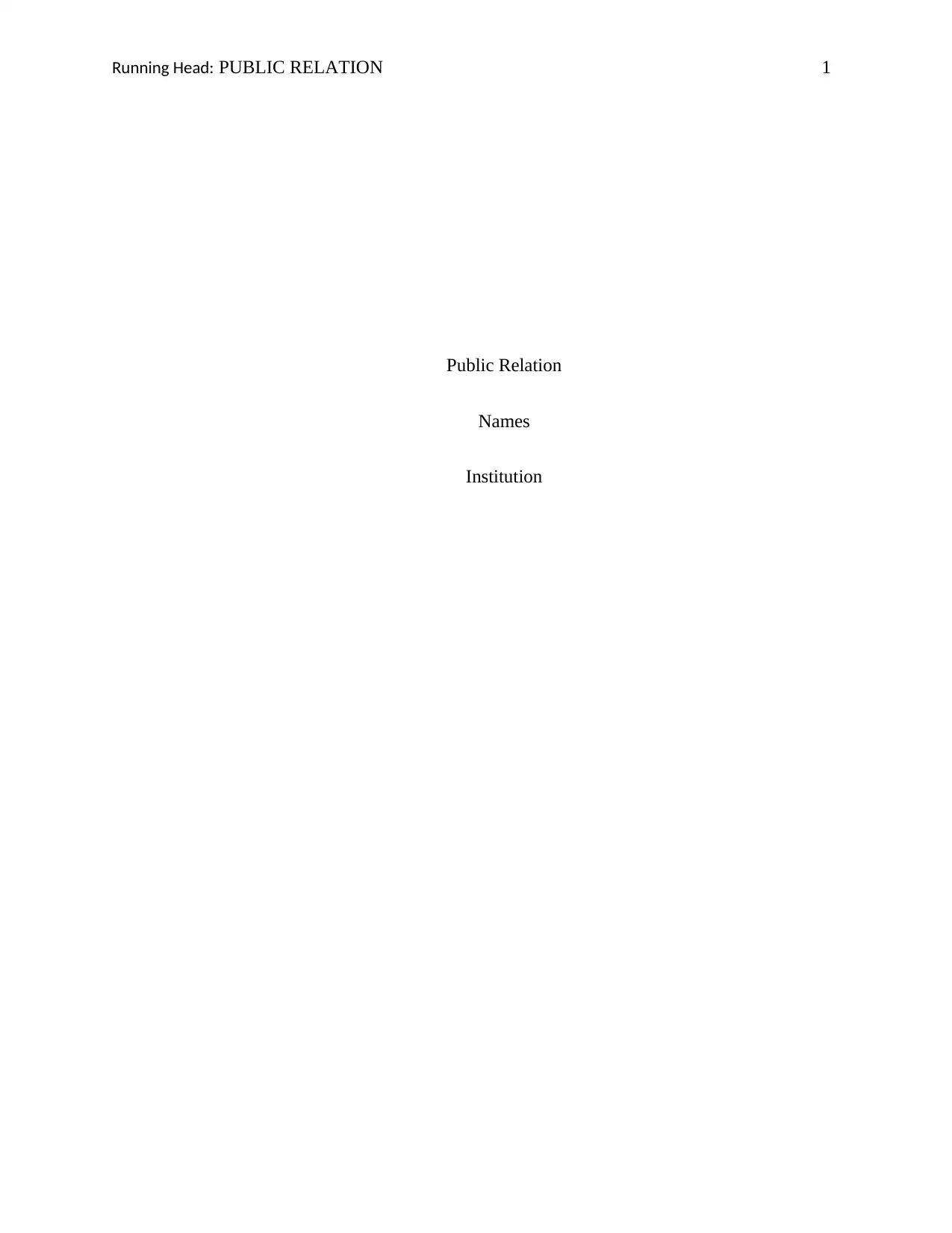
Running Head: PUBLIC RELATION 1
Public Relation
Names
Institution
Public Relation
Names
Institution
Paraphrase This Document
Need a fresh take? Get an instant paraphrase of this document with our AI Paraphraser
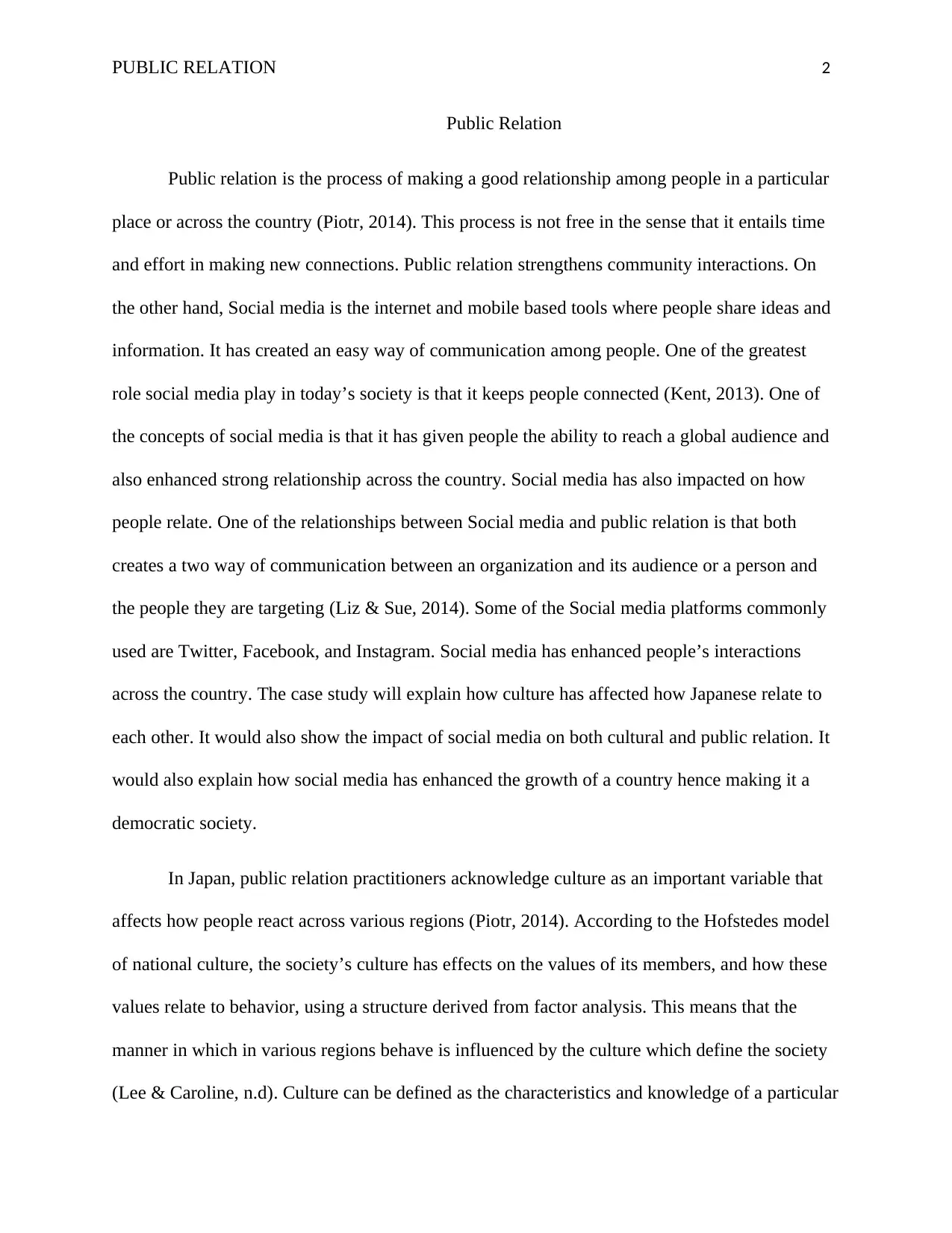
PUBLIC RELATION 2
Public Relation
Public relation is the process of making a good relationship among people in a particular
place or across the country (Piotr, 2014). This process is not free in the sense that it entails time
and effort in making new connections. Public relation strengthens community interactions. On
the other hand, Social media is the internet and mobile based tools where people share ideas and
information. It has created an easy way of communication among people. One of the greatest
role social media play in today’s society is that it keeps people connected (Kent, 2013). One of
the concepts of social media is that it has given people the ability to reach a global audience and
also enhanced strong relationship across the country. Social media has also impacted on how
people relate. One of the relationships between Social media and public relation is that both
creates a two way of communication between an organization and its audience or a person and
the people they are targeting (Liz & Sue, 2014). Some of the Social media platforms commonly
used are Twitter, Facebook, and Instagram. Social media has enhanced people’s interactions
across the country. The case study will explain how culture has affected how Japanese relate to
each other. It would also show the impact of social media on both cultural and public relation. It
would also explain how social media has enhanced the growth of a country hence making it a
democratic society.
In Japan, public relation practitioners acknowledge culture as an important variable that
affects how people react across various regions (Piotr, 2014). According to the Hofstedes model
of national culture, the society’s culture has effects on the values of its members, and how these
values relate to behavior, using a structure derived from factor analysis. This means that the
manner in which in various regions behave is influenced by the culture which define the society
(Lee & Caroline, n.d). Culture can be defined as the characteristics and knowledge of a particular
Public Relation
Public relation is the process of making a good relationship among people in a particular
place or across the country (Piotr, 2014). This process is not free in the sense that it entails time
and effort in making new connections. Public relation strengthens community interactions. On
the other hand, Social media is the internet and mobile based tools where people share ideas and
information. It has created an easy way of communication among people. One of the greatest
role social media play in today’s society is that it keeps people connected (Kent, 2013). One of
the concepts of social media is that it has given people the ability to reach a global audience and
also enhanced strong relationship across the country. Social media has also impacted on how
people relate. One of the relationships between Social media and public relation is that both
creates a two way of communication between an organization and its audience or a person and
the people they are targeting (Liz & Sue, 2014). Some of the Social media platforms commonly
used are Twitter, Facebook, and Instagram. Social media has enhanced people’s interactions
across the country. The case study will explain how culture has affected how Japanese relate to
each other. It would also show the impact of social media on both cultural and public relation. It
would also explain how social media has enhanced the growth of a country hence making it a
democratic society.
In Japan, public relation practitioners acknowledge culture as an important variable that
affects how people react across various regions (Piotr, 2014). According to the Hofstedes model
of national culture, the society’s culture has effects on the values of its members, and how these
values relate to behavior, using a structure derived from factor analysis. This means that the
manner in which in various regions behave is influenced by the culture which define the society
(Lee & Caroline, n.d). Culture can be defined as the characteristics and knowledge of a particular
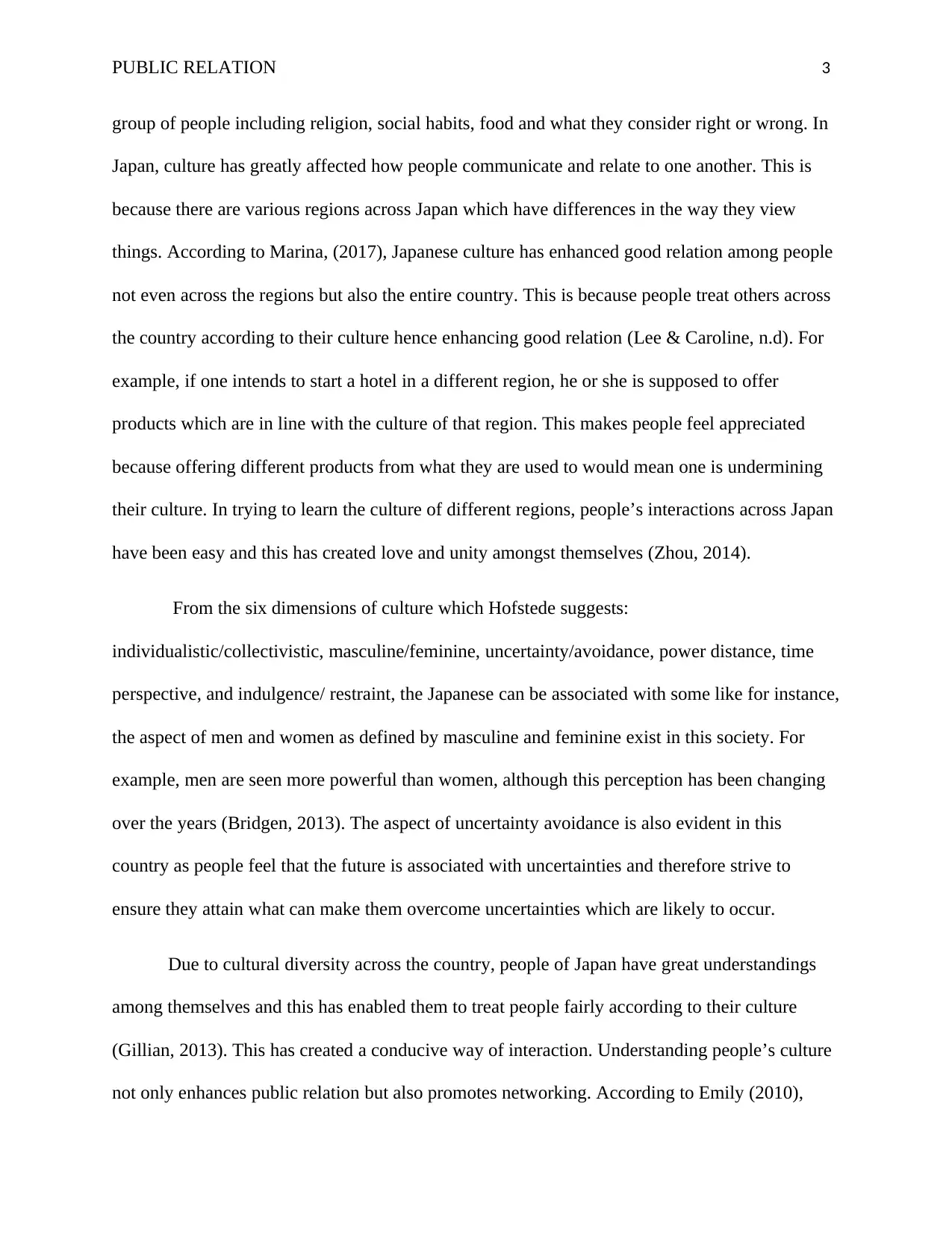
PUBLIC RELATION 3
group of people including religion, social habits, food and what they consider right or wrong. In
Japan, culture has greatly affected how people communicate and relate to one another. This is
because there are various regions across Japan which have differences in the way they view
things. According to Marina, (2017), Japanese culture has enhanced good relation among people
not even across the regions but also the entire country. This is because people treat others across
the country according to their culture hence enhancing good relation (Lee & Caroline, n.d). For
example, if one intends to start a hotel in a different region, he or she is supposed to offer
products which are in line with the culture of that region. This makes people feel appreciated
because offering different products from what they are used to would mean one is undermining
their culture. In trying to learn the culture of different regions, people’s interactions across Japan
have been easy and this has created love and unity amongst themselves (Zhou, 2014).
From the six dimensions of culture which Hofstede suggests:
individualistic/collectivistic, masculine/feminine, uncertainty/avoidance, power distance, time
perspective, and indulgence/ restraint, the Japanese can be associated with some like for instance,
the aspect of men and women as defined by masculine and feminine exist in this society. For
example, men are seen more powerful than women, although this perception has been changing
over the years (Bridgen, 2013). The aspect of uncertainty avoidance is also evident in this
country as people feel that the future is associated with uncertainties and therefore strive to
ensure they attain what can make them overcome uncertainties which are likely to occur.
Due to cultural diversity across the country, people of Japan have great understandings
among themselves and this has enabled them to treat people fairly according to their culture
(Gillian, 2013). This has created a conducive way of interaction. Understanding people’s culture
not only enhances public relation but also promotes networking. According to Emily (2010),
group of people including religion, social habits, food and what they consider right or wrong. In
Japan, culture has greatly affected how people communicate and relate to one another. This is
because there are various regions across Japan which have differences in the way they view
things. According to Marina, (2017), Japanese culture has enhanced good relation among people
not even across the regions but also the entire country. This is because people treat others across
the country according to their culture hence enhancing good relation (Lee & Caroline, n.d). For
example, if one intends to start a hotel in a different region, he or she is supposed to offer
products which are in line with the culture of that region. This makes people feel appreciated
because offering different products from what they are used to would mean one is undermining
their culture. In trying to learn the culture of different regions, people’s interactions across Japan
have been easy and this has created love and unity amongst themselves (Zhou, 2014).
From the six dimensions of culture which Hofstede suggests:
individualistic/collectivistic, masculine/feminine, uncertainty/avoidance, power distance, time
perspective, and indulgence/ restraint, the Japanese can be associated with some like for instance,
the aspect of men and women as defined by masculine and feminine exist in this society. For
example, men are seen more powerful than women, although this perception has been changing
over the years (Bridgen, 2013). The aspect of uncertainty avoidance is also evident in this
country as people feel that the future is associated with uncertainties and therefore strive to
ensure they attain what can make them overcome uncertainties which are likely to occur.
Due to cultural diversity across the country, people of Japan have great understandings
among themselves and this has enabled them to treat people fairly according to their culture
(Gillian, 2013). This has created a conducive way of interaction. Understanding people’s culture
not only enhances public relation but also promotes networking. According to Emily (2010),
⊘ This is a preview!⊘
Do you want full access?
Subscribe today to unlock all pages.

Trusted by 1+ million students worldwide
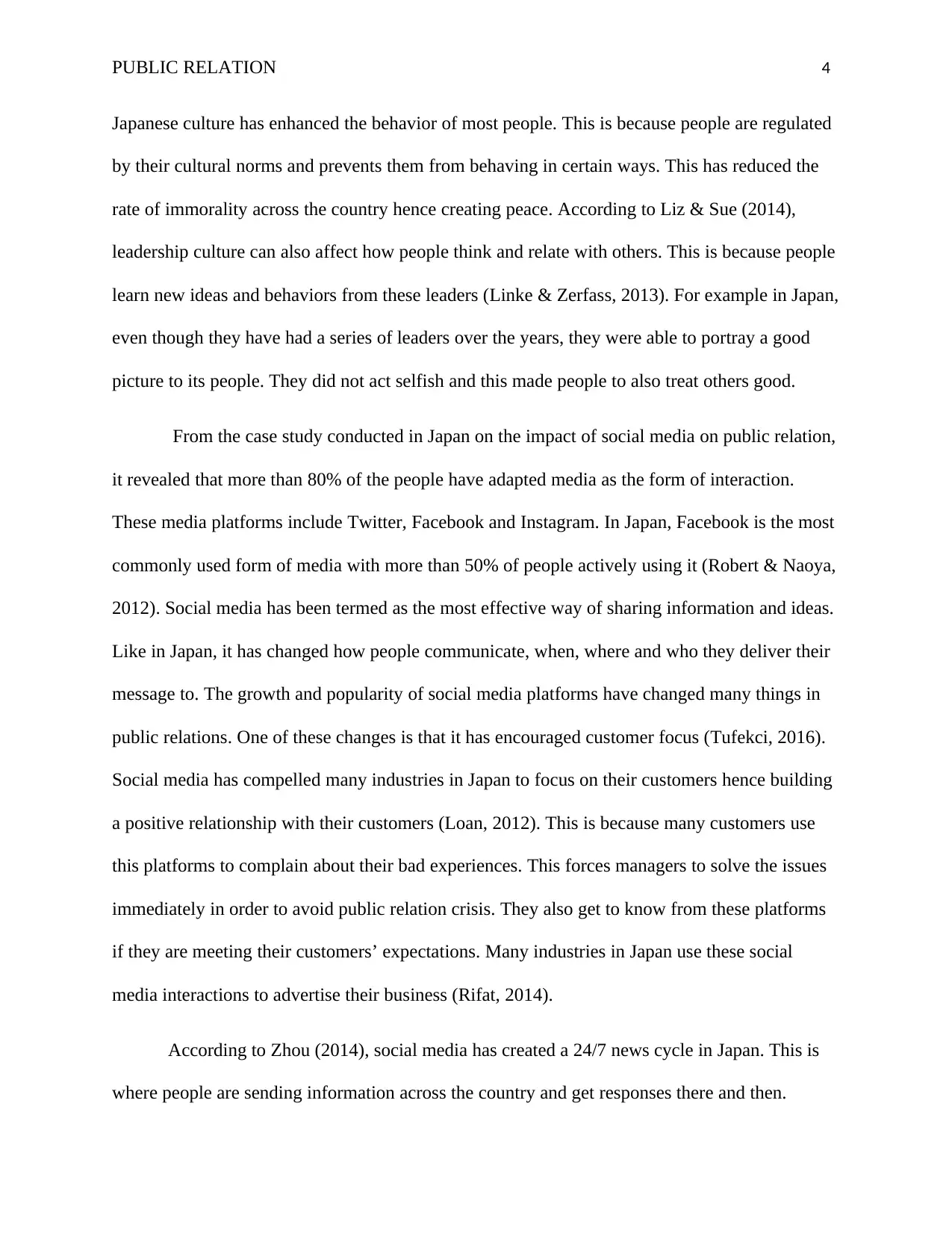
PUBLIC RELATION 4
Japanese culture has enhanced the behavior of most people. This is because people are regulated
by their cultural norms and prevents them from behaving in certain ways. This has reduced the
rate of immorality across the country hence creating peace. According to Liz & Sue (2014),
leadership culture can also affect how people think and relate with others. This is because people
learn new ideas and behaviors from these leaders (Linke & Zerfass, 2013). For example in Japan,
even though they have had a series of leaders over the years, they were able to portray a good
picture to its people. They did not act selfish and this made people to also treat others good.
From the case study conducted in Japan on the impact of social media on public relation,
it revealed that more than 80% of the people have adapted media as the form of interaction.
These media platforms include Twitter, Facebook and Instagram. In Japan, Facebook is the most
commonly used form of media with more than 50% of people actively using it (Robert & Naoya,
2012). Social media has been termed as the most effective way of sharing information and ideas.
Like in Japan, it has changed how people communicate, when, where and who they deliver their
message to. The growth and popularity of social media platforms have changed many things in
public relations. One of these changes is that it has encouraged customer focus (Tufekci, 2016).
Social media has compelled many industries in Japan to focus on their customers hence building
a positive relationship with their customers (Loan, 2012). This is because many customers use
this platforms to complain about their bad experiences. This forces managers to solve the issues
immediately in order to avoid public relation crisis. They also get to know from these platforms
if they are meeting their customers’ expectations. Many industries in Japan use these social
media interactions to advertise their business (Rifat, 2014).
According to Zhou (2014), social media has created a 24/7 news cycle in Japan. This is
where people are sending information across the country and get responses there and then.
Japanese culture has enhanced the behavior of most people. This is because people are regulated
by their cultural norms and prevents them from behaving in certain ways. This has reduced the
rate of immorality across the country hence creating peace. According to Liz & Sue (2014),
leadership culture can also affect how people think and relate with others. This is because people
learn new ideas and behaviors from these leaders (Linke & Zerfass, 2013). For example in Japan,
even though they have had a series of leaders over the years, they were able to portray a good
picture to its people. They did not act selfish and this made people to also treat others good.
From the case study conducted in Japan on the impact of social media on public relation,
it revealed that more than 80% of the people have adapted media as the form of interaction.
These media platforms include Twitter, Facebook and Instagram. In Japan, Facebook is the most
commonly used form of media with more than 50% of people actively using it (Robert & Naoya,
2012). Social media has been termed as the most effective way of sharing information and ideas.
Like in Japan, it has changed how people communicate, when, where and who they deliver their
message to. The growth and popularity of social media platforms have changed many things in
public relations. One of these changes is that it has encouraged customer focus (Tufekci, 2016).
Social media has compelled many industries in Japan to focus on their customers hence building
a positive relationship with their customers (Loan, 2012). This is because many customers use
this platforms to complain about their bad experiences. This forces managers to solve the issues
immediately in order to avoid public relation crisis. They also get to know from these platforms
if they are meeting their customers’ expectations. Many industries in Japan use these social
media interactions to advertise their business (Rifat, 2014).
According to Zhou (2014), social media has created a 24/7 news cycle in Japan. This is
where people are sending information across the country and get responses there and then.
Paraphrase This Document
Need a fresh take? Get an instant paraphrase of this document with our AI Paraphraser
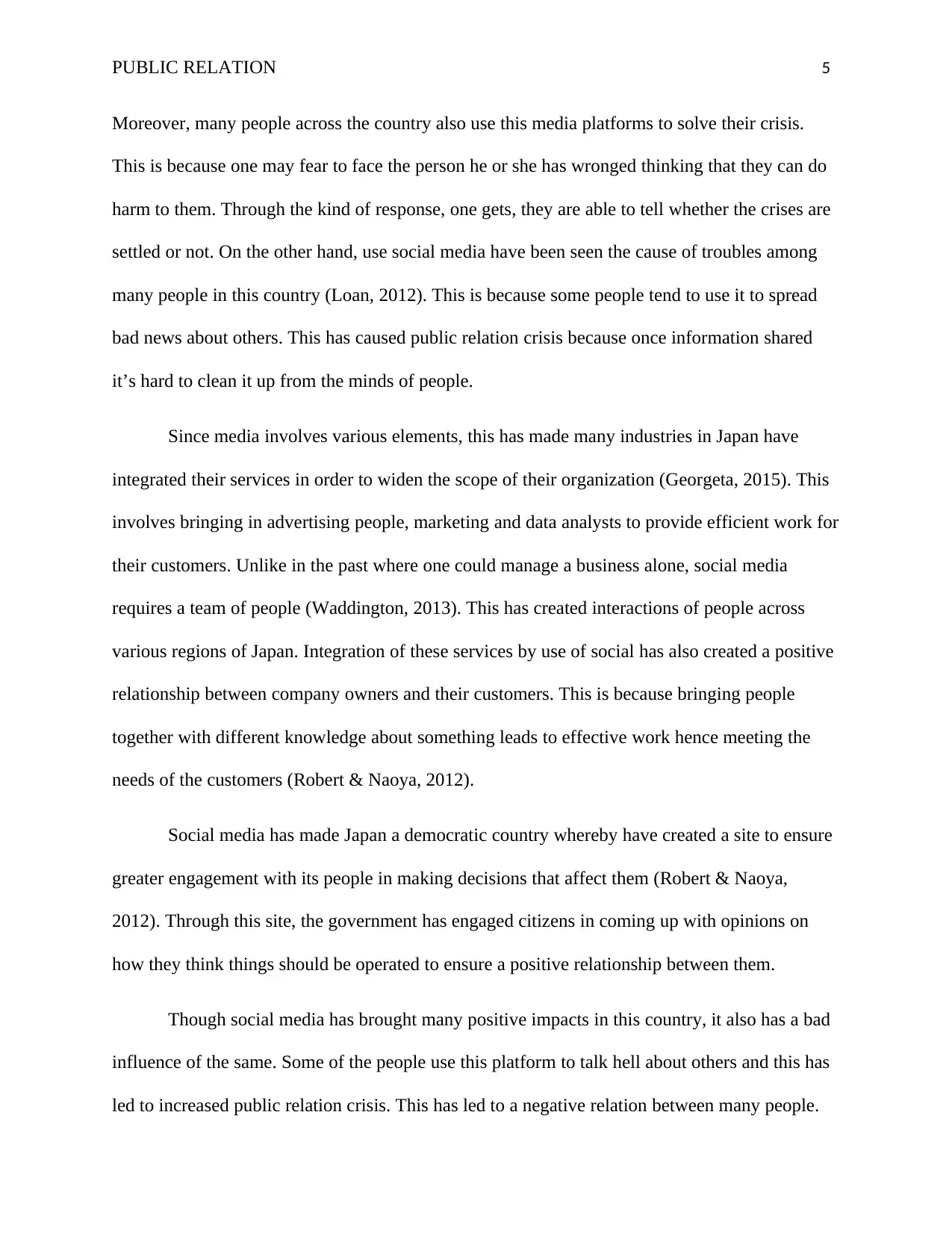
PUBLIC RELATION 5
Moreover, many people across the country also use this media platforms to solve their crisis.
This is because one may fear to face the person he or she has wronged thinking that they can do
harm to them. Through the kind of response, one gets, they are able to tell whether the crises are
settled or not. On the other hand, use social media have been seen the cause of troubles among
many people in this country (Loan, 2012). This is because some people tend to use it to spread
bad news about others. This has caused public relation crisis because once information shared
it’s hard to clean it up from the minds of people.
Since media involves various elements, this has made many industries in Japan have
integrated their services in order to widen the scope of their organization (Georgeta, 2015). This
involves bringing in advertising people, marketing and data analysts to provide efficient work for
their customers. Unlike in the past where one could manage a business alone, social media
requires a team of people (Waddington, 2013). This has created interactions of people across
various regions of Japan. Integration of these services by use of social has also created a positive
relationship between company owners and their customers. This is because bringing people
together with different knowledge about something leads to effective work hence meeting the
needs of the customers (Robert & Naoya, 2012).
Social media has made Japan a democratic country whereby have created a site to ensure
greater engagement with its people in making decisions that affect them (Robert & Naoya,
2012). Through this site, the government has engaged citizens in coming up with opinions on
how they think things should be operated to ensure a positive relationship between them.
Though social media has brought many positive impacts in this country, it also has a bad
influence of the same. Some of the people use this platform to talk hell about others and this has
led to increased public relation crisis. This has led to a negative relation between many people.
Moreover, many people across the country also use this media platforms to solve their crisis.
This is because one may fear to face the person he or she has wronged thinking that they can do
harm to them. Through the kind of response, one gets, they are able to tell whether the crises are
settled or not. On the other hand, use social media have been seen the cause of troubles among
many people in this country (Loan, 2012). This is because some people tend to use it to spread
bad news about others. This has caused public relation crisis because once information shared
it’s hard to clean it up from the minds of people.
Since media involves various elements, this has made many industries in Japan have
integrated their services in order to widen the scope of their organization (Georgeta, 2015). This
involves bringing in advertising people, marketing and data analysts to provide efficient work for
their customers. Unlike in the past where one could manage a business alone, social media
requires a team of people (Waddington, 2013). This has created interactions of people across
various regions of Japan. Integration of these services by use of social has also created a positive
relationship between company owners and their customers. This is because bringing people
together with different knowledge about something leads to effective work hence meeting the
needs of the customers (Robert & Naoya, 2012).
Social media has made Japan a democratic country whereby have created a site to ensure
greater engagement with its people in making decisions that affect them (Robert & Naoya,
2012). Through this site, the government has engaged citizens in coming up with opinions on
how they think things should be operated to ensure a positive relationship between them.
Though social media has brought many positive impacts in this country, it also has a bad
influence of the same. Some of the people use this platform to talk hell about others and this has
led to increased public relation crisis. This has led to a negative relation between many people.
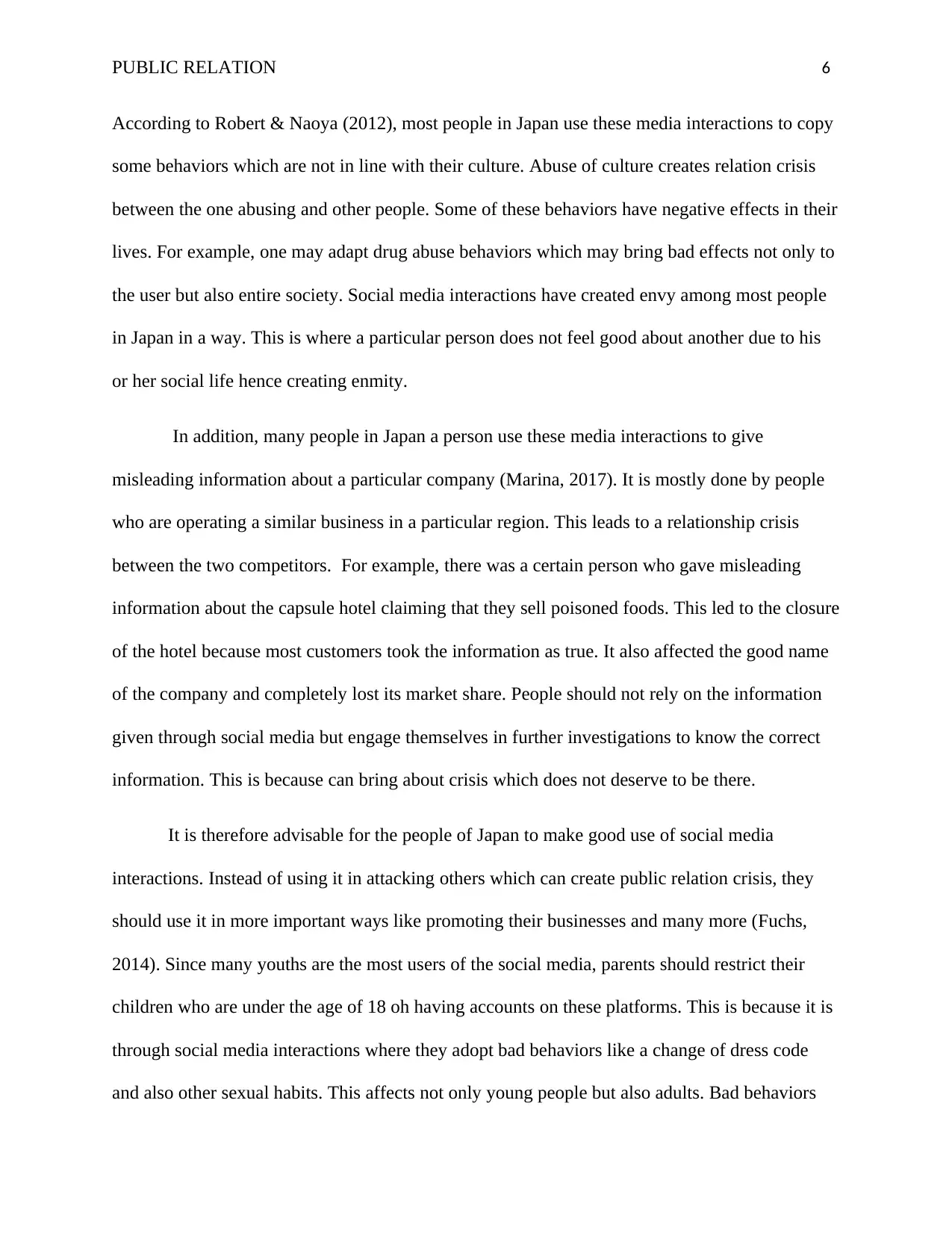
PUBLIC RELATION 6
According to Robert & Naoya (2012), most people in Japan use these media interactions to copy
some behaviors which are not in line with their culture. Abuse of culture creates relation crisis
between the one abusing and other people. Some of these behaviors have negative effects in their
lives. For example, one may adapt drug abuse behaviors which may bring bad effects not only to
the user but also entire society. Social media interactions have created envy among most people
in Japan in a way. This is where a particular person does not feel good about another due to his
or her social life hence creating enmity.
In addition, many people in Japan a person use these media interactions to give
misleading information about a particular company (Marina, 2017). It is mostly done by people
who are operating a similar business in a particular region. This leads to a relationship crisis
between the two competitors. For example, there was a certain person who gave misleading
information about the capsule hotel claiming that they sell poisoned foods. This led to the closure
of the hotel because most customers took the information as true. It also affected the good name
of the company and completely lost its market share. People should not rely on the information
given through social media but engage themselves in further investigations to know the correct
information. This is because can bring about crisis which does not deserve to be there.
It is therefore advisable for the people of Japan to make good use of social media
interactions. Instead of using it in attacking others which can create public relation crisis, they
should use it in more important ways like promoting their businesses and many more (Fuchs,
2014). Since many youths are the most users of the social media, parents should restrict their
children who are under the age of 18 oh having accounts on these platforms. This is because it is
through social media interactions where they adopt bad behaviors like a change of dress code
and also other sexual habits. This affects not only young people but also adults. Bad behaviors
According to Robert & Naoya (2012), most people in Japan use these media interactions to copy
some behaviors which are not in line with their culture. Abuse of culture creates relation crisis
between the one abusing and other people. Some of these behaviors have negative effects in their
lives. For example, one may adapt drug abuse behaviors which may bring bad effects not only to
the user but also entire society. Social media interactions have created envy among most people
in Japan in a way. This is where a particular person does not feel good about another due to his
or her social life hence creating enmity.
In addition, many people in Japan a person use these media interactions to give
misleading information about a particular company (Marina, 2017). It is mostly done by people
who are operating a similar business in a particular region. This leads to a relationship crisis
between the two competitors. For example, there was a certain person who gave misleading
information about the capsule hotel claiming that they sell poisoned foods. This led to the closure
of the hotel because most customers took the information as true. It also affected the good name
of the company and completely lost its market share. People should not rely on the information
given through social media but engage themselves in further investigations to know the correct
information. This is because can bring about crisis which does not deserve to be there.
It is therefore advisable for the people of Japan to make good use of social media
interactions. Instead of using it in attacking others which can create public relation crisis, they
should use it in more important ways like promoting their businesses and many more (Fuchs,
2014). Since many youths are the most users of the social media, parents should restrict their
children who are under the age of 18 oh having accounts on these platforms. This is because it is
through social media interactions where they adopt bad behaviors like a change of dress code
and also other sexual habits. This affects not only young people but also adults. Bad behaviors
⊘ This is a preview!⊘
Do you want full access?
Subscribe today to unlock all pages.

Trusted by 1+ million students worldwide
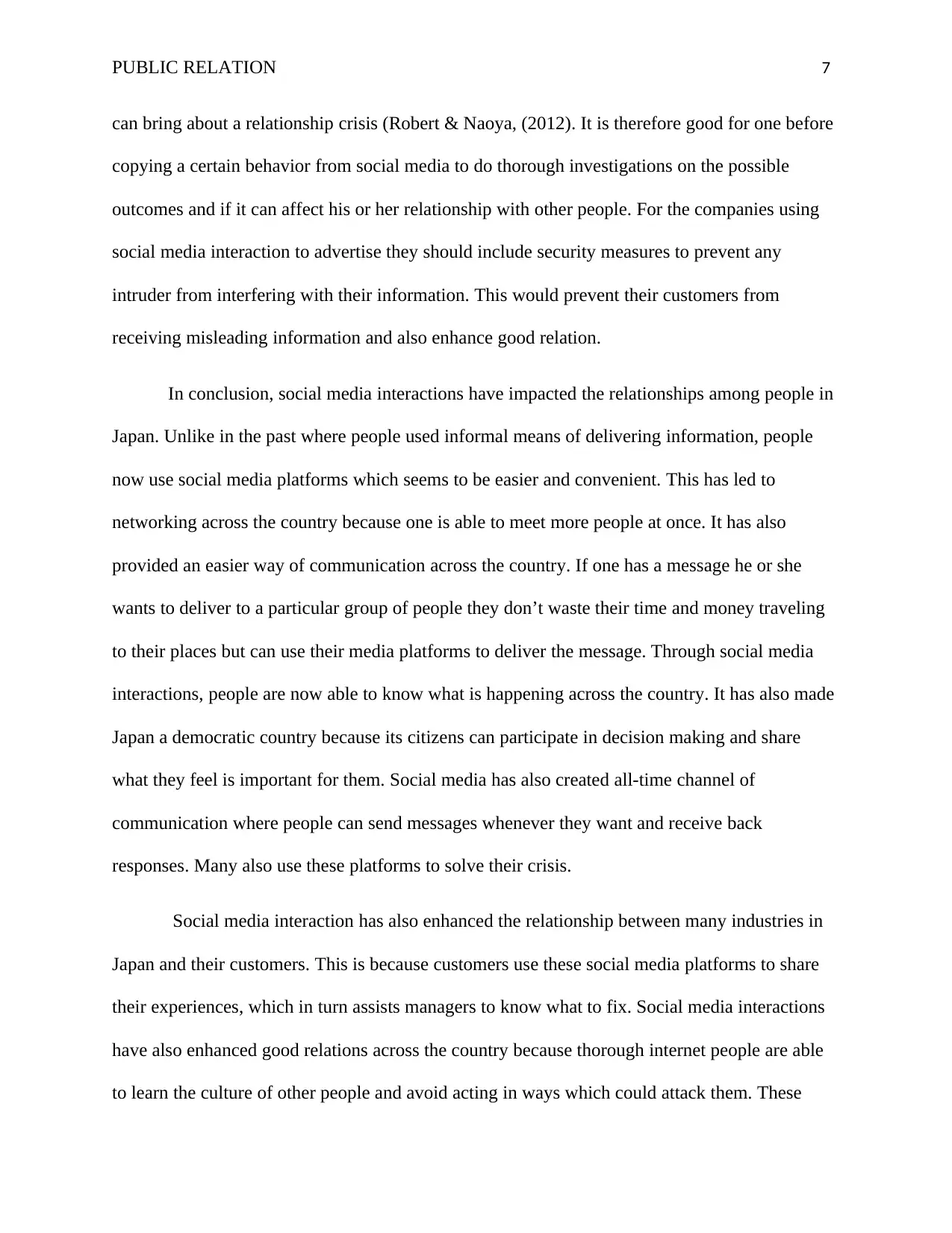
PUBLIC RELATION 7
can bring about a relationship crisis (Robert & Naoya, (2012). It is therefore good for one before
copying a certain behavior from social media to do thorough investigations on the possible
outcomes and if it can affect his or her relationship with other people. For the companies using
social media interaction to advertise they should include security measures to prevent any
intruder from interfering with their information. This would prevent their customers from
receiving misleading information and also enhance good relation.
In conclusion, social media interactions have impacted the relationships among people in
Japan. Unlike in the past where people used informal means of delivering information, people
now use social media platforms which seems to be easier and convenient. This has led to
networking across the country because one is able to meet more people at once. It has also
provided an easier way of communication across the country. If one has a message he or she
wants to deliver to a particular group of people they don’t waste their time and money traveling
to their places but can use their media platforms to deliver the message. Through social media
interactions, people are now able to know what is happening across the country. It has also made
Japan a democratic country because its citizens can participate in decision making and share
what they feel is important for them. Social media has also created all-time channel of
communication where people can send messages whenever they want and receive back
responses. Many also use these platforms to solve their crisis.
Social media interaction has also enhanced the relationship between many industries in
Japan and their customers. This is because customers use these social media platforms to share
their experiences, which in turn assists managers to know what to fix. Social media interactions
have also enhanced good relations across the country because thorough internet people are able
to learn the culture of other people and avoid acting in ways which could attack them. These
can bring about a relationship crisis (Robert & Naoya, (2012). It is therefore good for one before
copying a certain behavior from social media to do thorough investigations on the possible
outcomes and if it can affect his or her relationship with other people. For the companies using
social media interaction to advertise they should include security measures to prevent any
intruder from interfering with their information. This would prevent their customers from
receiving misleading information and also enhance good relation.
In conclusion, social media interactions have impacted the relationships among people in
Japan. Unlike in the past where people used informal means of delivering information, people
now use social media platforms which seems to be easier and convenient. This has led to
networking across the country because one is able to meet more people at once. It has also
provided an easier way of communication across the country. If one has a message he or she
wants to deliver to a particular group of people they don’t waste their time and money traveling
to their places but can use their media platforms to deliver the message. Through social media
interactions, people are now able to know what is happening across the country. It has also made
Japan a democratic country because its citizens can participate in decision making and share
what they feel is important for them. Social media has also created all-time channel of
communication where people can send messages whenever they want and receive back
responses. Many also use these platforms to solve their crisis.
Social media interaction has also enhanced the relationship between many industries in
Japan and their customers. This is because customers use these social media platforms to share
their experiences, which in turn assists managers to know what to fix. Social media interactions
have also enhanced good relations across the country because thorough internet people are able
to learn the culture of other people and avoid acting in ways which could attack them. These
Paraphrase This Document
Need a fresh take? Get an instant paraphrase of this document with our AI Paraphraser
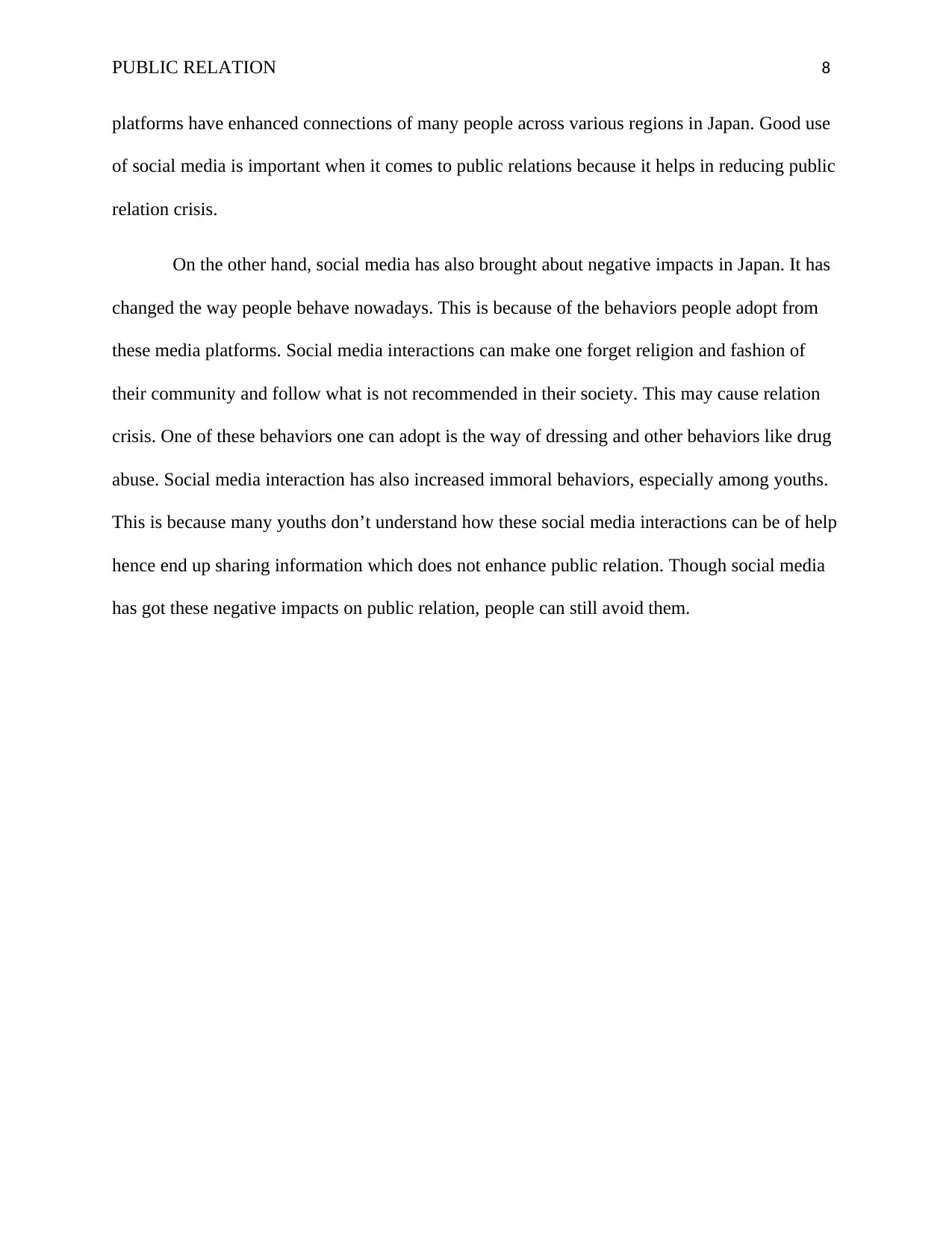
PUBLIC RELATION 8
platforms have enhanced connections of many people across various regions in Japan. Good use
of social media is important when it comes to public relations because it helps in reducing public
relation crisis.
On the other hand, social media has also brought about negative impacts in Japan. It has
changed the way people behave nowadays. This is because of the behaviors people adopt from
these media platforms. Social media interactions can make one forget religion and fashion of
their community and follow what is not recommended in their society. This may cause relation
crisis. One of these behaviors one can adopt is the way of dressing and other behaviors like drug
abuse. Social media interaction has also increased immoral behaviors, especially among youths.
This is because many youths don’t understand how these social media interactions can be of help
hence end up sharing information which does not enhance public relation. Though social media
has got these negative impacts on public relation, people can still avoid them.
platforms have enhanced connections of many people across various regions in Japan. Good use
of social media is important when it comes to public relations because it helps in reducing public
relation crisis.
On the other hand, social media has also brought about negative impacts in Japan. It has
changed the way people behave nowadays. This is because of the behaviors people adopt from
these media platforms. Social media interactions can make one forget religion and fashion of
their community and follow what is not recommended in their society. This may cause relation
crisis. One of these behaviors one can adopt is the way of dressing and other behaviors like drug
abuse. Social media interaction has also increased immoral behaviors, especially among youths.
This is because many youths don’t understand how these social media interactions can be of help
hence end up sharing information which does not enhance public relation. Though social media
has got these negative impacts on public relation, people can still avoid them.
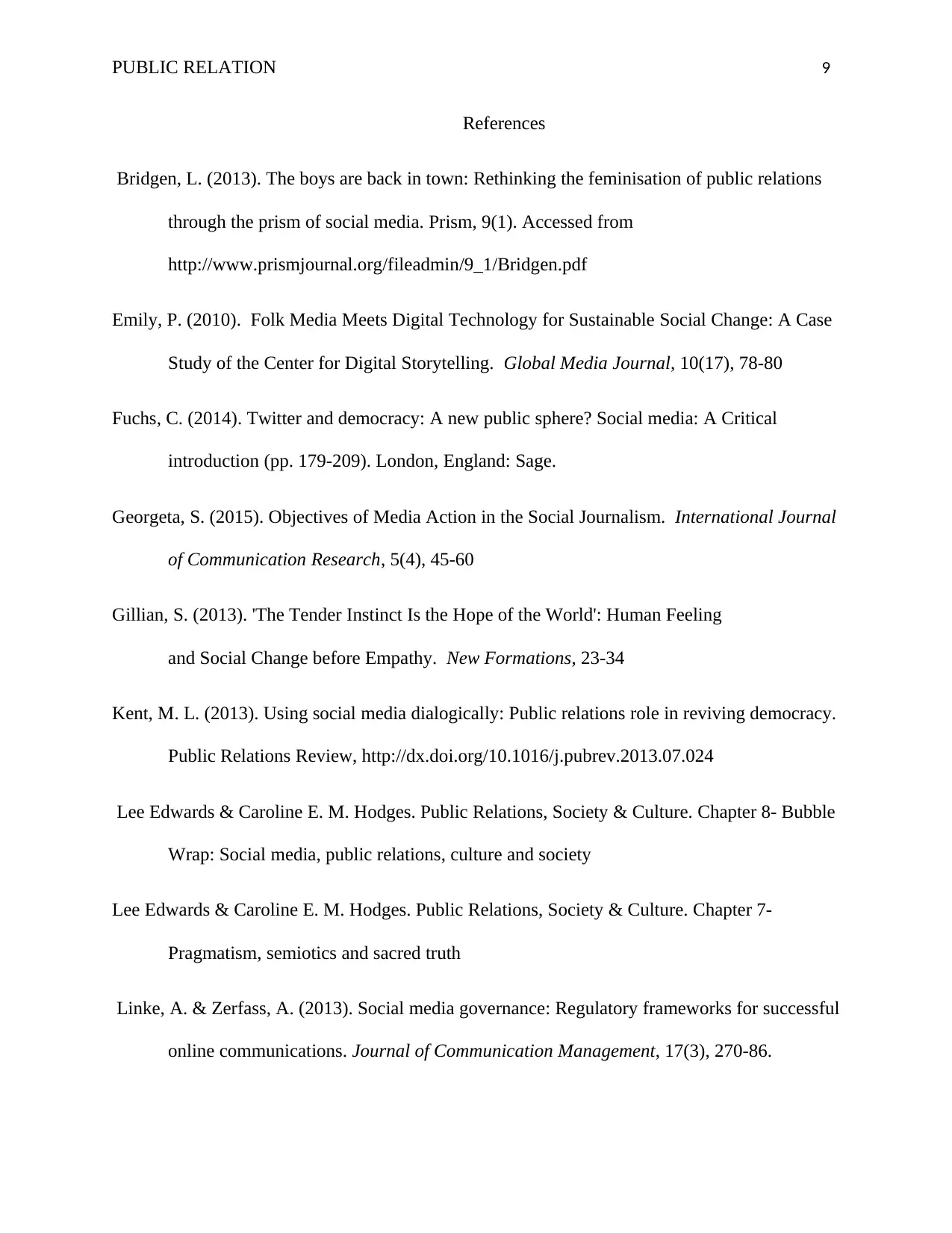
PUBLIC RELATION 9
References
Bridgen, L. (2013). The boys are back in town: Rethinking the feminisation of public relations
through the prism of social media. Prism, 9(1). Accessed from
http://www.prismjournal.org/fileadmin/9_1/Bridgen.pdf
Emily, P. (2010). Folk Media Meets Digital Technology for Sustainable Social Change: A Case
Study of the Center for Digital Storytelling. Global Media Journal, 10(17), 78-80
Fuchs, C. (2014). Twitter and democracy: A new public sphere? Social media: A Critical
introduction (pp. 179-209). London, England: Sage.
Georgeta, S. (2015). Objectives of Media Action in the Social Journalism. International Journal
of Communication Research, 5(4), 45-60
Gillian, S. (2013). 'The Tender Instinct Is the Hope of the World': Human Feeling
and Social Change before Empathy. New Formations, 23-34
Kent, M. L. (2013). Using social media dialogically: Public relations role in reviving democracy.
Public Relations Review, http://dx.doi.org/10.1016/j.pubrev.2013.07.024
Lee Edwards & Caroline E. M. Hodges. Public Relations, Society & Culture. Chapter 8- Bubble
Wrap: Social media, public relations, culture and society
Lee Edwards & Caroline E. M. Hodges. Public Relations, Society & Culture. Chapter 7-
Pragmatism, semiotics and sacred truth
Linke, A. & Zerfass, A. (2013). Social media governance: Regulatory frameworks for successful
online communications. Journal of Communication Management, 17(3), 270-86.
References
Bridgen, L. (2013). The boys are back in town: Rethinking the feminisation of public relations
through the prism of social media. Prism, 9(1). Accessed from
http://www.prismjournal.org/fileadmin/9_1/Bridgen.pdf
Emily, P. (2010). Folk Media Meets Digital Technology for Sustainable Social Change: A Case
Study of the Center for Digital Storytelling. Global Media Journal, 10(17), 78-80
Fuchs, C. (2014). Twitter and democracy: A new public sphere? Social media: A Critical
introduction (pp. 179-209). London, England: Sage.
Georgeta, S. (2015). Objectives of Media Action in the Social Journalism. International Journal
of Communication Research, 5(4), 45-60
Gillian, S. (2013). 'The Tender Instinct Is the Hope of the World': Human Feeling
and Social Change before Empathy. New Formations, 23-34
Kent, M. L. (2013). Using social media dialogically: Public relations role in reviving democracy.
Public Relations Review, http://dx.doi.org/10.1016/j.pubrev.2013.07.024
Lee Edwards & Caroline E. M. Hodges. Public Relations, Society & Culture. Chapter 8- Bubble
Wrap: Social media, public relations, culture and society
Lee Edwards & Caroline E. M. Hodges. Public Relations, Society & Culture. Chapter 7-
Pragmatism, semiotics and sacred truth
Linke, A. & Zerfass, A. (2013). Social media governance: Regulatory frameworks for successful
online communications. Journal of Communication Management, 17(3), 270-86.
⊘ This is a preview!⊘
Do you want full access?
Subscribe today to unlock all pages.

Trusted by 1+ million students worldwide
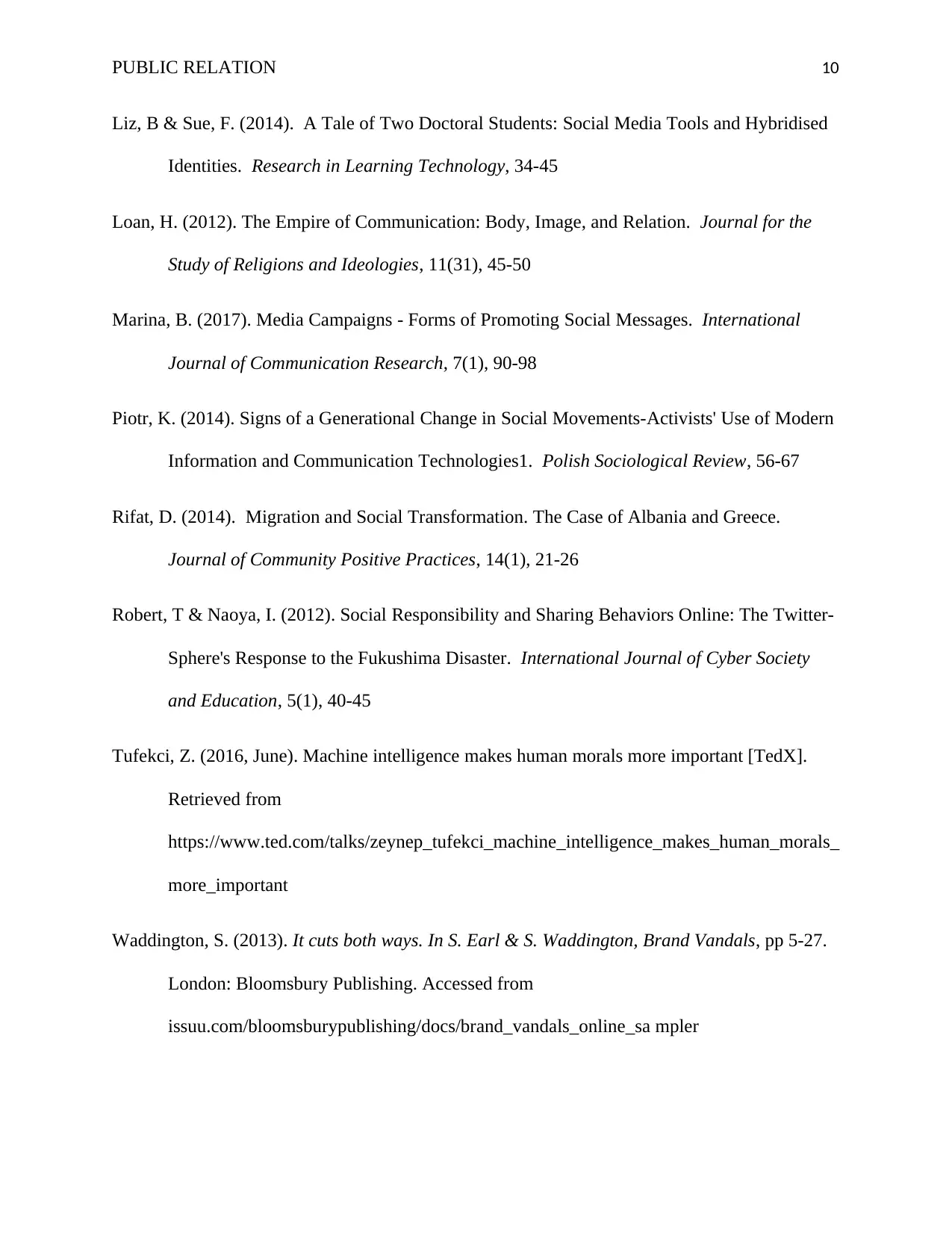
PUBLIC RELATION 10
Liz, B & Sue, F. (2014). A Tale of Two Doctoral Students: Social Media Tools and Hybridised
Identities. Research in Learning Technology, 34-45
Loan, H. (2012). The Empire of Communication: Body, Image, and Relation. Journal for the
Study of Religions and Ideologies, 11(31), 45-50
Marina, B. (2017). Media Campaigns - Forms of Promoting Social Messages. International
Journal of Communication Research, 7(1), 90-98
Piotr, K. (2014). Signs of a Generational Change in Social Movements-Activists' Use of Modern
Information and Communication Technologies1. Polish Sociological Review, 56-67
Rifat, D. (2014). Migration and Social Transformation. The Case of Albania and Greece.
Journal of Community Positive Practices, 14(1), 21-26
Robert, T & Naoya, I. (2012). Social Responsibility and Sharing Behaviors Online: The Twitter-
Sphere's Response to the Fukushima Disaster. International Journal of Cyber Society
and Education, 5(1), 40-45
Tufekci, Z. (2016, June). Machine intelligence makes human morals more important [TedX].
Retrieved from
https://www.ted.com/talks/zeynep_tufekci_machine_intelligence_makes_human_morals_
more_important
Waddington, S. (2013). It cuts both ways. In S. Earl & S. Waddington, Brand Vandals, pp 5-27.
London: Bloomsbury Publishing. Accessed from
issuu.com/bloomsburypublishing/docs/brand_vandals_online_sa mpler
Liz, B & Sue, F. (2014). A Tale of Two Doctoral Students: Social Media Tools and Hybridised
Identities. Research in Learning Technology, 34-45
Loan, H. (2012). The Empire of Communication: Body, Image, and Relation. Journal for the
Study of Religions and Ideologies, 11(31), 45-50
Marina, B. (2017). Media Campaigns - Forms of Promoting Social Messages. International
Journal of Communication Research, 7(1), 90-98
Piotr, K. (2014). Signs of a Generational Change in Social Movements-Activists' Use of Modern
Information and Communication Technologies1. Polish Sociological Review, 56-67
Rifat, D. (2014). Migration and Social Transformation. The Case of Albania and Greece.
Journal of Community Positive Practices, 14(1), 21-26
Robert, T & Naoya, I. (2012). Social Responsibility and Sharing Behaviors Online: The Twitter-
Sphere's Response to the Fukushima Disaster. International Journal of Cyber Society
and Education, 5(1), 40-45
Tufekci, Z. (2016, June). Machine intelligence makes human morals more important [TedX].
Retrieved from
https://www.ted.com/talks/zeynep_tufekci_machine_intelligence_makes_human_morals_
more_important
Waddington, S. (2013). It cuts both ways. In S. Earl & S. Waddington, Brand Vandals, pp 5-27.
London: Bloomsbury Publishing. Accessed from
issuu.com/bloomsburypublishing/docs/brand_vandals_online_sa mpler
Paraphrase This Document
Need a fresh take? Get an instant paraphrase of this document with our AI Paraphraser
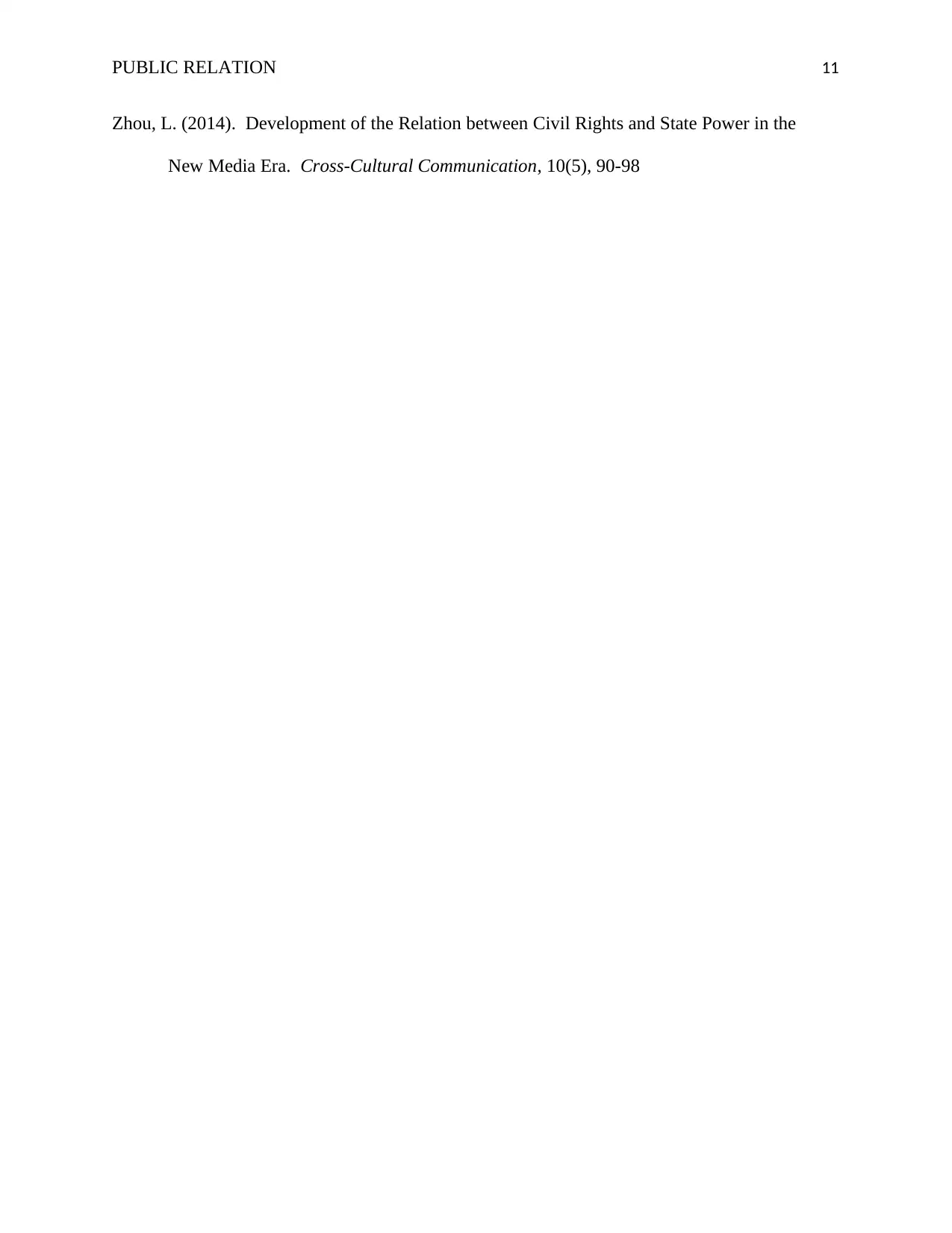
PUBLIC RELATION 11
Zhou, L. (2014). Development of the Relation between Civil Rights and State Power in the
New Media Era. Cross-Cultural Communication, 10(5), 90-98
Zhou, L. (2014). Development of the Relation between Civil Rights and State Power in the
New Media Era. Cross-Cultural Communication, 10(5), 90-98
1 out of 11
Related Documents
Your All-in-One AI-Powered Toolkit for Academic Success.
+13062052269
info@desklib.com
Available 24*7 on WhatsApp / Email
![[object Object]](/_next/static/media/star-bottom.7253800d.svg)
Unlock your academic potential
Copyright © 2020–2025 A2Z Services. All Rights Reserved. Developed and managed by ZUCOL.





